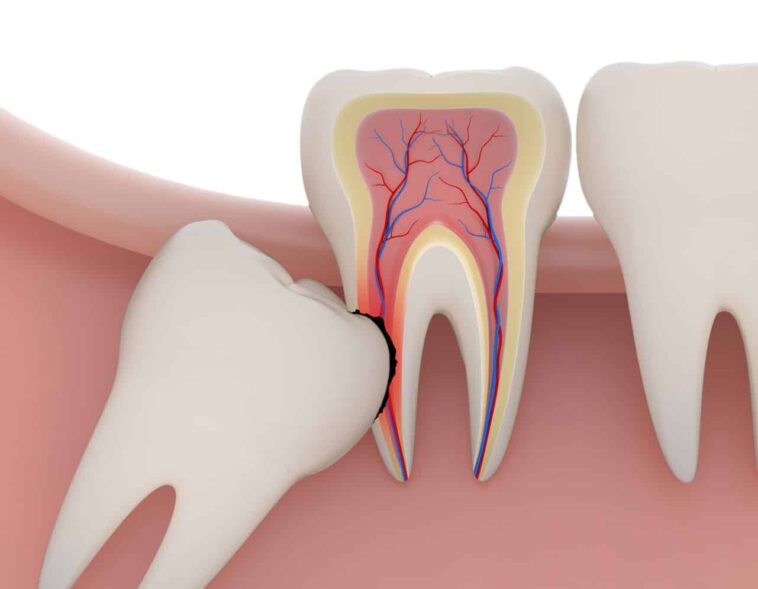Wisdom teeth are a third pair of molars located in the back of the mouth. These teeth start to move up beyond your jawbone between the ages of 17 and 25 on their way to breaking through your gum line and becoming part of the chewing mechanism. Wisdom teeth usually appear in late adolescence or early adolescence. Although some people have a smooth eruption with no issues, others might feel wisdom teeth pain.
When your wisdom teeth are causing you pain, your oral surgeon or dentist may advise you to have them extracted. Wisdom teeth are frequently impacted, meaning they cannot fully enter the mouth. They occasionally fail to break through the gums. The following are the root cause of wisdom tooth pain, symptoms to watch for, and treatment options.
Wisdom Tooth Pain Causes
You may implement proactive pain management measures when you wait for the operation. Below are some issues that may prompt your dentist or doctor to urge wisdom tooth extraction:
- Inadequate Space: A shortage of space in the jaw is a prevalent root of wisdom tooth pain. As they mature, these molars can press against neighboring teeth, creating discomfort and anguish.
- Impaction: Wisdom teeth might get impacted, preventing them from fully erupting through the gums. Around seventy percent of adults have at least a single impacted wisdom tooth. Impacted teeth can cause inflammation, swelling, and excruciating pain.
- Infection: Whenever wisdom teeth partially erupt, they create a gap that may catch particles of food and bacteria, resulting in infection and pain.
- Damage: An impacted tooth can cause damage to neighboring teeth. Some people develop a cyst around their wisdom teeth. Furthermore, the position of wisdom teeth makes them more difficult to clean, which could lead to poor oral hygiene.
Wisdom Tooth Pain Symptoms

Wisdom Tooth Pain can result in varied symptoms and they are listed as below:
- Jaw Pain: One of the most prevalent symptoms of wisdom teeth pain is jaw discomfort. The discomfort may spread to nearby locations, including your ears and temples.
- Swelling and Redness: Swelling, discomfort and redness may occur if the gum tissue surrounding the developing or impacted wisdom teeth gets inflamed. Whenever food particles and germs become caught around a partially erupted wisdom tooth, they can create poor breath or a foul taste in the mouth.
- Trouble Opening Mouth: Wisdom teeth pain might make it difficult to expand the mouth fully or cause discomfort when biting or chewing down.
Pain Relief From Wisdom Teeth
For a long time, the usual approach for dealing with wisdom teeth has been to yank them out immediately as they appear. Dentists are becoming more skeptical of tooth extractions since wisdom tooth pain can get severe. There is also the chance of negative effects following their elimination, and the removal technique is sometimes uncomplicated.
Gum inflammation can occur even when wisdom teeth are erupting normally. This inflammation may be controlled in a short period, such as three to four days, with correct management and without requiring extraction.
Proper management entails better oral hygiene, cleaning between the teeth, and visiting the dentist regularly; sugary, sticky foods should be avoided and consuming a proper amount of water. Below are some ways to get rid of wisdom tooth pain:
- Pain relievers sold over the counter: Non-prescription pain relievers such as acetaminophen or ibuprofen can temporarily relieve wisdom teeth discomfort. Carefully follow the dosing directions.
- Saltwater Rinse: Rinse your mouth often daily with warm salt water to cleanse the region and inflammation and offer temporary comfort.
- Topical Anesthetics: Applying oral numbing gels or topical lotions to the area of concern might temporarily relieve pain.
- Ice packs or cold compresses: When ice packs are applied to the outside of your cheek will assist in minimizing swelling and numb the region, offering temporary relief.
- Maintaining Good Oral Hygiene: Keeping the region around your wisdom teeth clean is critical. Floss and brush gently, providing special attention to the rear of the mouth to avoid further difficulties.
- Consult a Dentist: When the discomfort persists or worsens, you should see a dentist. They can assess your case, do an X-ray to discover the source of your pain and propose suitable options for treatment.
Understand The Wisdom Tooth Removal Method:

If the discomfort persists for an extended time, an oral surgeon must be consulted, and extraction may be recommended. Wisdom tooth extraction is a simple oral surgical treatment that can be conducted safely in a dental clinic with local anesthesia or mild sedation by an oral and maxillofacial surgeon.
The time required for wisdom tooth removal differs based on numerous factors. It generally takes between 20 and 40 minutes. The surgeon ensures the treatment is painless by delivering appropriate anesthesia that numbs the tooth and associated jaw bone.
Following anesthesia, the surgeon applies gentle pressure to loosen the tooth. It is often necessary to section the tooth to extract it without removing superfluous bone. The patient must follow a few post-operative instructions and recommendations after tooth extraction.
After The Procedure
You will be brought to a recovery room after the treatment if you have sedation or general anesthesia. You will most likely spend your recovery period in the dentist’s chair if you receive local anesthesia. As you recover from your operation, follow your dentist’s recommendations for:
- Bleeding: The initial day following wisdom teeth removal may result in some blood seeping. Prevent spitting excessively.
- Pain Control: You can control your discomfort with over-the-counter pain relievers like acetaminophen (Tylenol, for example) or with prescribed pain medication from the dentist or oral surgeon.
- Bruising and Redness: As advised by your dentist or surgeon, apply an ice pack.
- Activity: Plan to rest for the remaining hours of the day post the procedure. The following day, resume routine activities.
- Beverages: Drink plenty of water following surgery. In the initial 24 hours, avoid alcoholic, carbonated, caffeinated, or hot beverages.
- Food: For 24 hours, eat mainly soft foods like yogurt or applesauce.
- It would help if you brushed your teeth. Throughout the initial 24 hours following surgery, do not brush your teeth, clean your mouth, spit, or use mouthwash.
- Tobacco Consumption: If you smoke, refrain from doing so for at least 72 hours following surgery, preferably longer.
- Stitches: You could have stitches that dissolve in a couple of weeks or none.

Conclusion
Wisdom tooth pain is a typical dental problem that many people have. Understanding the reasons and symptoms might assist you in identifying and effectively managing the discomfort. You can manage wisdom tooth pain and obtain relief by using numerous home remedies and getting expert dental care whenever necessary. See a dentist for an accurate diagnosis and personalized treatment plan to safeguard your oral health and general well-being.
If you’re planning to get your wisdom tooth removed, you can reach out to this expert dentist in Melbourne to get started.




